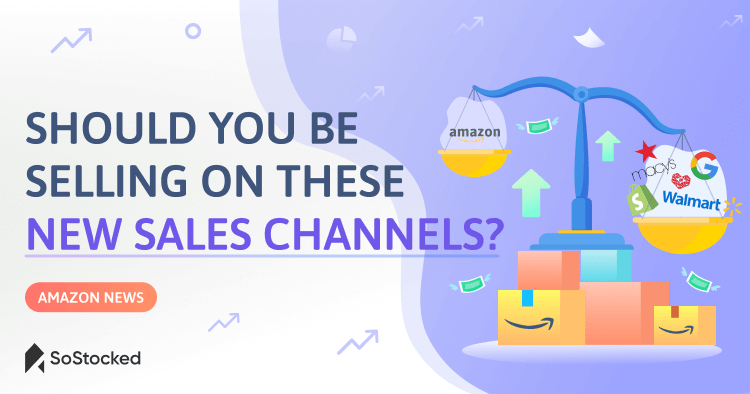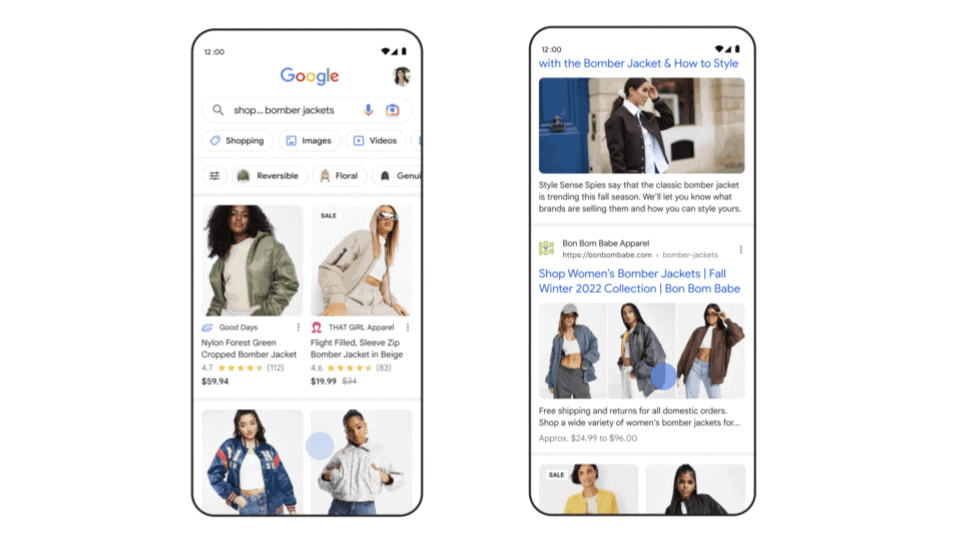
Should You Be Selling on These New Sales Channels?
🥊 Macy’s, Pinduoduo, and Google have just joined Walmart and Shopify in battling Amazon for the US market share!
This means greater marketplace diversity for sellers, especially for those who are looking for (cheaper) alternatives to Amazon, which as previously reported, has gotten 30% more expensive in the last two years.
For Amazon, however, tougher competition is an incentive for them to keep innovating (i.e., launch new tools, services, or products) so they can stay in the game and continue capturing more independent sellers and consumers.
Simply put, opening the market to emerging players not only generates more attractive offers, but also breaks up anti-competitive practices. 🔥
Introducing the New Amazon Challengers
Amazon is a global eCommerce leader with a reported revenue of $610 billion in 2021, surpassing America’s largest brick-and-mortar store, Walmart, with only $566 billion.
However, as big as Amazon is, it doesn’t stop new players from firing onto the scene. 🚀
Pinduoduo
On September 1, Chinese eCommerce giant, Pinduoduo, quietly launched its US online shopping site, Temu, in an attempt to replicate the international success of Shein and AliExpress. The company’s expansion to the US also offers new growth areas at a time when the Chinese tech sector is having a rough year due to the government’s tech crackdown.
We present this new marketplace to sellers not so much to consider selling on the platform, but more to provide a view of what new competition is coming that could steal clicks and purchases from sellers on Amazon.

What to expect with Pinduoduo
- Ideal for discount retailers. To keep the prices low on the platform, Pinduoduo negotiates with sellers to achieve the lowest offer possible. At a glance, the prices on Temu range from $0.99 to $25, making it a good online shopping destination for customers who love a good bargain.
- Extensive connection with manufacturers and merchants. The company works directly with over 11 million sellers from across the globe, which allows them to cut out the middlemen, aka distributors. They also don’t have in-house brands like Amazon does, as all products are supplied by third-party sellers.
- 10-billion worth of resource packages for Chinese manufacturers. Pinduoduo launched an overseas support initiative that aims to help 10,000 domestic factories sell internationally.
- No warehouses in the US. All products are shipped from China, which suggests delivery may take longer than 2 days. If customers prefer 1- to 2-day shipping, Pinduoduo may not be the best alternative marketplace for them.
- Low margin business. As mentioned earlier, most products on Temu are sold at bargain prices, so depending on market demand, you may make profit, break even, or lose money. In addition, unsold products (let’s say more than 90 days) may be returned to you, and when it does happen, you will sustain a loss. Alternatively, you can try to join Temu’s flash sales to attract more customers.
- Potential counterfeit issues. In 2018, Pinduoduo was added to the US Trade Representative’s blacklist over suspected fakes. This means you could face the same intellectual property issues that are troubling Shein sellers.
Pinduoduo may be a good option for suppliers in China who want to easily connect with US customers. But for Amazon sellers, that means that your suppliers could quickly become your competitors, if they aren’t already.
Macy’s, Inc.
On September 28, the department store chain officially welcomed third-party sellers to its eCommerce site, macys.com.
Powered by Mirakl, a top online marketplace technology provider, the new digital channel now allows you to seamlessly integrate your products into Macy’s and access tools that will help you to monitor and grow your business.
As of this writing, Macy’s provides customers with 400 new brands, 20 product categories, and sustainable offerings from women-owned and diverse-owned businesses.

Reasons to join Macy’s
- Guided onboarding process. The retailer will work with a select group of sellers and brand partners to ensure they meet Macy’s product and fulfillment standards. They will also offer seller support, training programs, and promotional participation.
- Sellers will be denoted by a badge. A “Shipped by and sold by” badge will be displayed on your product listings to differentiate yourself from other brands and communicate who’s responsible for fulfilling and shipping customer orders.
- Send your products for approval and listing. Similar to Pinduoduo, Macy’s makes the final decision as to which products end up on the marketplace. This helps the company to maintain a well-curated assortment of goods, control product prices, and combat counterfeiting.
Reasons not to join
- Seller-fulfilled orders. As a third-party seller, you’ll be responsible for processing your own orders. If you don’t have the storage space and manpower to fulfill orders yourself, you may need to hire a third-party fulfillment company to pack and ship items for you, which means added costs and complexity to your operations.
- Fierce competition. Like Amazon, Macy’s has multiple in-house brands that you need to compete with, not to mention the other private label brands from participating third-party sellers. And as the platform owner, they could easily collect and use customer data and analytics to gain an edge over direct competitors.
Advanced sellers may find Macy’s an excellent addition to their multi-sales channel strategy, whereas beginners or smaller businesses may struggle with the downsides of fulfilling orders themselves and competing in a highly competitive marketplace.
Released the same day as Macy’s new digital marketplace launch, Google has nine (9) new online shopping features and tools designed to offer a more efficient way for you to discover and shop products on its search engine.
Introduced at the recent Search On event, these new features include:

- Search with the word “shop,” followed by brand name, product type and category, among other relevant search terms.
- Shop the look. Find and buy your preferred clothing ensemble (e.g., summer outfit) within Google search.
- Trending products. Check out what’s trending in Search to discover the latest styles, models, and brands.
- Shop in 3D. Engage with 3D visuals of staple products like home goods, clothing, and sneakers as you search them on Google.
- Buying guides. Make an informed buying decision by reading all the relevant information about a product from trusted sources. If you’re looking to buy a road bike, for example, the buying guide feature might display information about the item’s size, weight, materials, fork suspension, wheelset, and so on. Arming yourself with this information will allow you to make decisions with a great deal of confidence.
- Page insights. Find out what other customers think about a product’s pros and cons.
- Personalized results. Enable personalized results on Google to narrow down your search to your preferences and previous shopping habits.
- New filters. Take advantage of dynamic shopping filters to discover what’s popular right now. If you’re shopping for sneakers, you might see filters for “retro” and “white” right below the search bar because those are the hottest styles.
- Suggested styles in Google app. If you prefer mobile shopping, use the Google app to browse through Google’s suggested styles for you. These suggestions will be based on your previous buys and what others have searched (and bought) too. Use the “Lens” feature to expand your shopping options.
Several of these features seem to be making Google a great resource for product research for sellers as well, so this is something to keep in mind the next time you look to find your new best seller.
Reasons to join Google
- Free for sellers. In a blog post, Google states that they have taken two steps to support all merchants: remove commission fees and make product discoverability free for sellers on Search. The tech giant uses a powerful AI called Shopping Graph that allows them to provide customers with relevant shopping information, such as brands, images, videos, product reviews, and inventory data from different sellers. If you have something a customer is looking for, your product ad or listing may show up on search. When a customer decides to buy it on Google, you won’t have to pay any commission fee (versus Amazon’s 8% to 15% fees).
- Plethora of shopping features and tools. Google is trying to establish itself as the one-stop-destination for customers. That’s why it’s introducing a suite of features designed to quickly sift through over 35 billion listings on the internet and bring a more personalized, immersive, and informative shopping experience.
- Optimized for Shopify merchants. Google has an existing partnership with Shopify that lets its merchants feature their products across Search, YouTube, Shopping, and more in just a few clicks. This collaboration helps sellers become highly discoverable to different types of buyers (intent buyers and window shoppers, for example), and as a result, drive traffic and boost conversion.
Reasons not to join Google
- Cut-throat competition. If you have a competitive product such as fashion and jewelry, you may experience difficulty in getting your ads to reach your target customers given that there may be thousands of others doing the same exact thing. Conversely, if you have a niche or rare product, you may have a better chance of attracting customers.
- Products could be disapproved or suspended. If you want to sell directly or advertise on Google Shopping, you have to get your products approved by meeting specific attributes and compliance requirements stated in the Shopping Ads policies. What may be allowed on Amazon may be prohibited on Google, so be sure to read up on the company’s product approval process to avoid potential issues that could delay your launch.
In sum, while expanding to new sales channels has its own advantages, it also has a few disadvantages, such as additional costs. It can also complicate your business operations, from sales & marketing (inconsistent messaging on different channels) to inventory management to fulfillment.
If you want to cast a wider net with a multi-channel selling strategy, make sure you understand the risks involved with selling on a particular sales channel. 👌
Related: Amazon FBA Calculator
Need more information?
- Send Message: We typically reply within 2 hours during office hours.
- Schedule Demo: Dive deeper into the nuances of our software with Chelsea.
- Join Live Upcoming Webinar: New to Amazon inventory management? Learn three inventory techniques you can implement right away.
 Start Your Free Audit
Start Your Free Audit